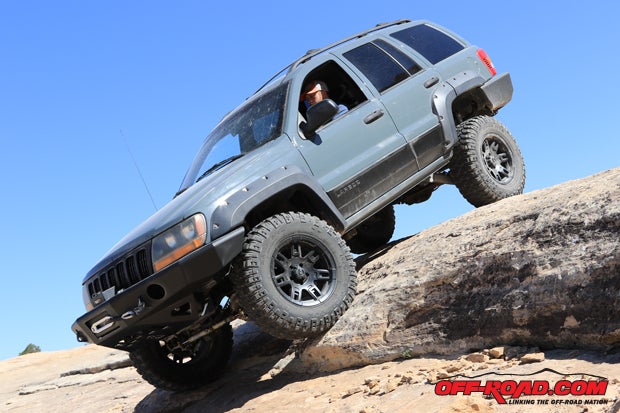
It’s been a long time coming, but after a few years of working on our project when and where we could, our Jeep Grand Cherokee WJ was finally ready to hit the trails. Sure, there are still a few tweaks needed here and there, but after many hours of work, some unforeseen fixes, and a few off months where the project sat and collected dust, our WJ was ready to get off the pavement.
We had a few adventures with our WJ thus far, one of which was at this year’s Easter Jeep Safari in Moab, Utah. We had fun cruising through the sandy washes, sandstone ledges and rocky trails to see how well the WJ handled the trails after all of the upgrades. It was a great first test.
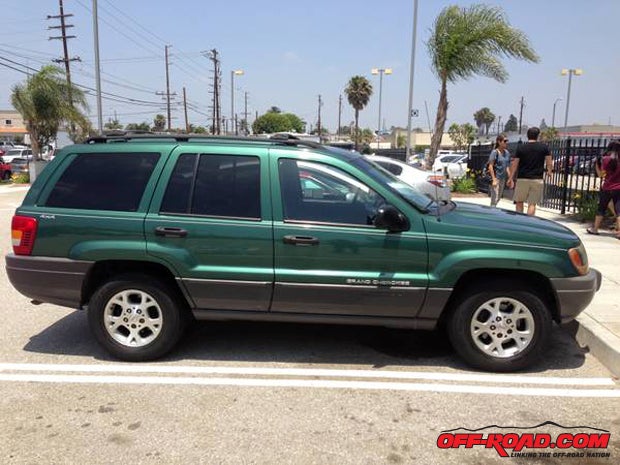
Our 1999 Grand Cherokee lived much of its life as a family SUV that was passed down through the family. Fortunately, in spite of its high mileage (over 175K when we bought it), the Jeep hadn’t seen much off-road use and therefore made for a great platform for our project since it wasn’t banged up from trail abuse. Our main reason for using the WJ platform is the availability of vehicles out there, its inexpensive price for the most part, and the fact that it’s the last live-axle setup on the Grand Cherokee before Jeep shifted to independent suspension on the 2005-2010 WK model. So the WJ is a uniquely cool vehicle, blending a level of off-road potential with more storage space than a traditional Wrangler, and realistic seat space for up to five.
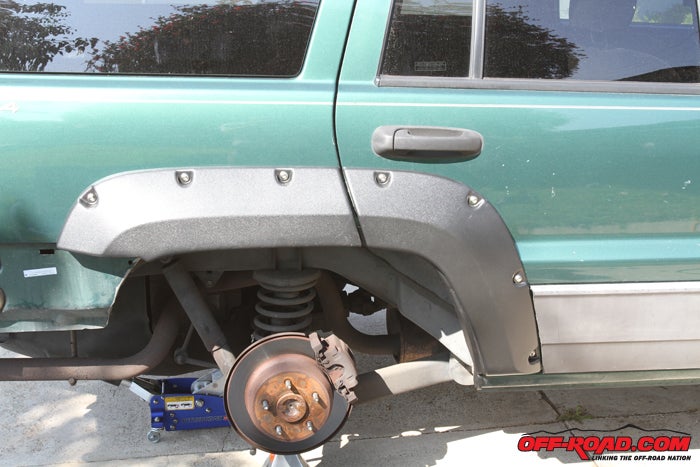
Jeep Grand Cherokee WJ: Bushwacker Flares, Maaco Paintjob
The catch, however, is that the stock WJ needs some massaging to unleash that off-road potential. Since the stock vehicle sits so close to the ground, and the wheels are tightly tucked into the wheels wells with very little room for suspension articulation, this is the first area we looked to address. We started out by trimming the sheet metal from the wheel wells to allow for larger tires and finish off the look in a clean way with Bushwacher’s Fender Flares. Since our 1999’s green paint had seen better days, we found a local MAACO shop that offered a reasonable price for a paintjob with a clear coat finish, we updated our rig’s look and used the modern Anvil color found on current JK Wranglers.
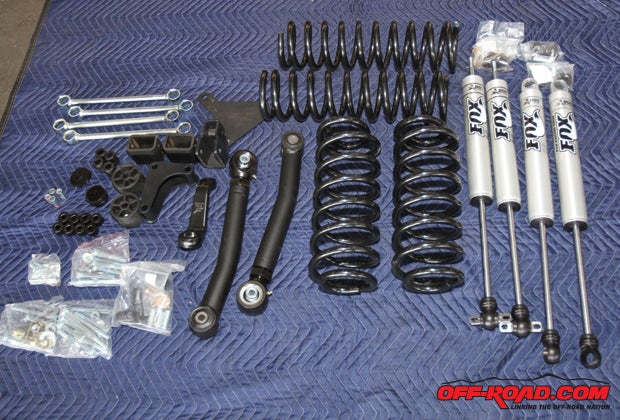
Jeep Grand Cherokee Project: BDS 4-Inch Suspension Install
Bushwacher fender flares alone weren’t going to offer the space we needed alone, so we reached out to BDS to pick up one of their 4-inch lift kits for the WJ. The kit not only would help get our Jeep off the ground, but the upgraded monotube Fox shocks would be a huge improvement to our Jeep’s on- and off-road performance. BDS’s dual-shock steering stabilizer also aided in the overall handling of our Jeep as well. BDS says the lift will accommodate up to 31-inch tires, but with the additional space opened up with the Bushwacher fender flares, 33s were a realistic goal.
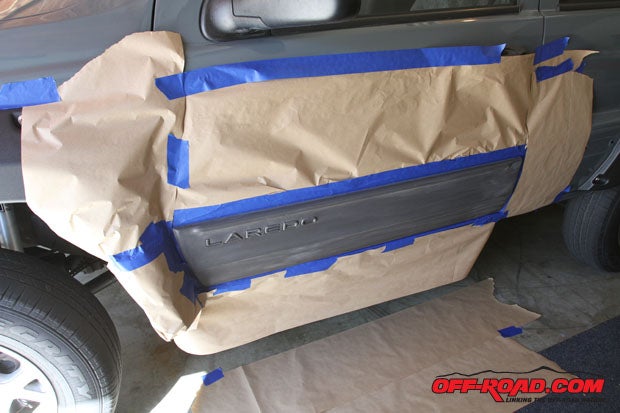
Project Jeep Grand Cherokee WJ: Cladding and Trim Cleanup
After the paintjob, our Jeep still needed some help in the looks department, as the grey plastic cladding and trim didn’t quite match up. We painted the grille and cladding with Krylon fusion rattle can, and to this point (after a year of sitting in the weather), it only now could use a little touchup, yet it still looks good at a glance.
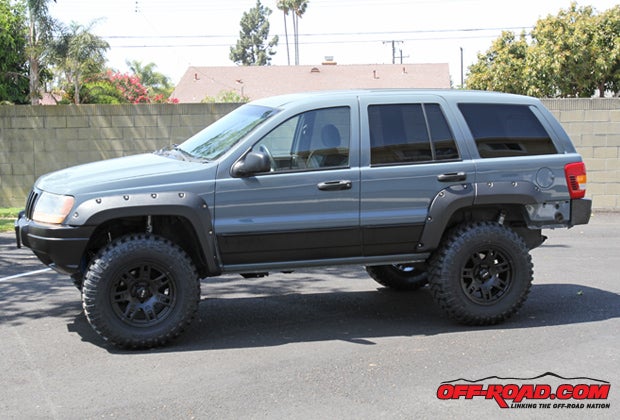
WJ Project: Mickey Thompson Sidebiter II Wheel, MTZ Tires
With space opened up in the wheel wells, we installed 33-inch Mickey Thompson MTZ tires on MT’s new Sidebiter II wheel. The black 17-inch wheels also perfectly matched our Anvil/black color scheme, while the MTZs provide an aggressive tread pattern for great off-road traction and good on-road performance.
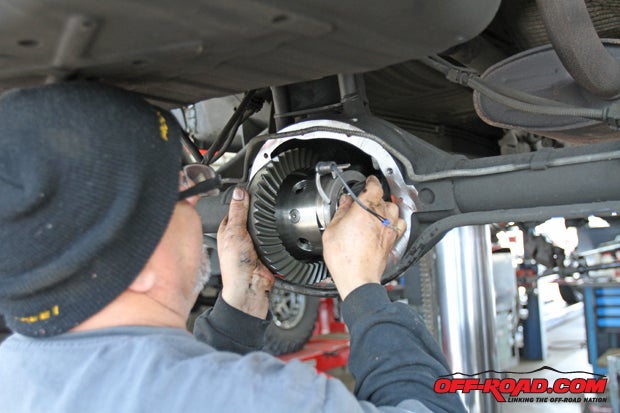
Jeep WJ Project: Detroit E-Locker, G2 Gear Installation
Similar to non-Rubicon Wranglers of the same era (i.e.: TJs), our Grand Cherokee sits on a Dana 30 front axle and a Dana 35 rear. Since this rig wouldn’t be a hard-core crawler and more so an all-around trail rig, we opted to stick with the stock axles and simply re-gear. We opted for 4.56 G2 gears to complement our new Mickey Thompson tire-and-wheel combination, and G2 differential covers would provide some additional protection and a fresh look underneath. Since we’d already have the diffs open, we decided to add Eaton E-Lockers for additional low-speed, off-road traction.
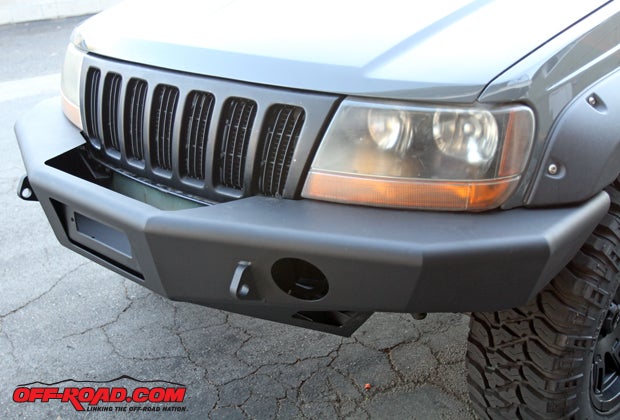
Trail Ready Jeep Grand Cherokee WJ Front Bumper Install
During the installation of our Bushwacker fender flares, we decided to remove the plastic stock bumper entirely, though the option to simply trim it to fit is outlined in the company’s instructions. We planned to eventually replace the stock front and rear bumpers with off-road versions, but we had a hard time finding viable options. Fortunately we came across units from Trail Ready, who offered a few different configurations for both the front and rear. We ordered up both new front and rear bumpers and swapped them out without much trouble.
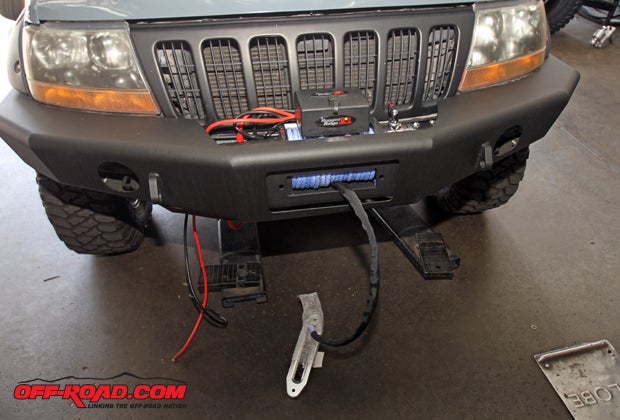
WJ Grand Cherokee: Installing a Tom Wood Custom Drive Shaft
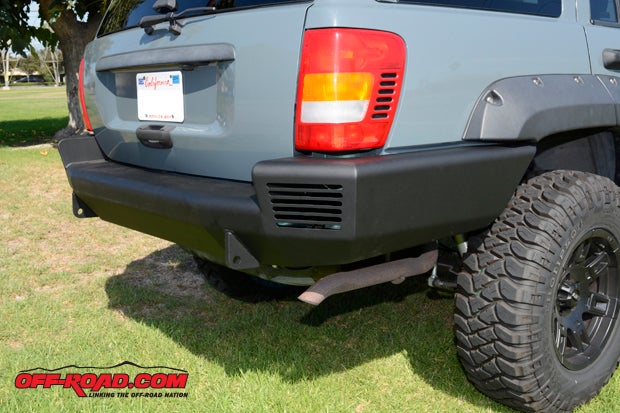
Trail Ready Jeep Grand Cherokee WJ Rear Bumper Installation
Although the new Trail Ready bumpers add a little bit of extra weight to our WJ, both are welcome changes for the stock plastic bumpers that aren’t trail friendly. The front bumper not only offers space for a winch, but it also incorporates a skid plate underneath for additional trail protection. Both the front and rear feature heavy-duty shackle mounts, they both nicely contour to the design lines of the Grand Cherokee, and both features a black powder coat finish that not only looks great but also helps prevent corrosion.
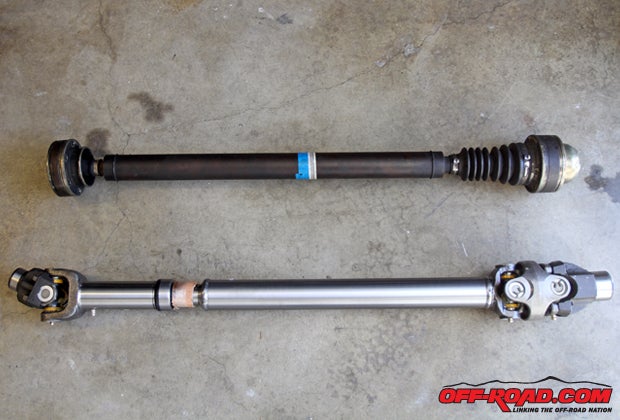
WJ Grand Cherokee: Installing a Tom Wood Custom Drive Shaft
Although BDS noted in the instructions for the 4-inch lift kit that a new front driveshaft would be needed, we didn’t notice any trouble with the front shaft’s geometry until after the lockers and gears were installed. It was clear we needed to address the vibration that was now present, so we reached out to Tom Wood’s Custom Drive Shafts, who built us a high-quality, double-cardan-style shaft to replace our stock unit. This virtually eliminated the vibration we felt after the re-gearing, and it also put the vehicle’s geometry back in line so that we won’t unnecessarily wear out drivetrain parts.
What We’ve Learned
Spending this much time working on any vehicle means you learn a lot about it – both the good and the bad. We’re happy with most everything we’ve done to the rig, and we’re happy with the final – or nearly final – product. The thing about a project is you’re never really done, right? One thing we’d still consider adding is more skid plate protection underneath. Although the Trail Ready front bumper offers some protection, the transmission, transfer-case and fuel tank are still far too exposed for our liking.
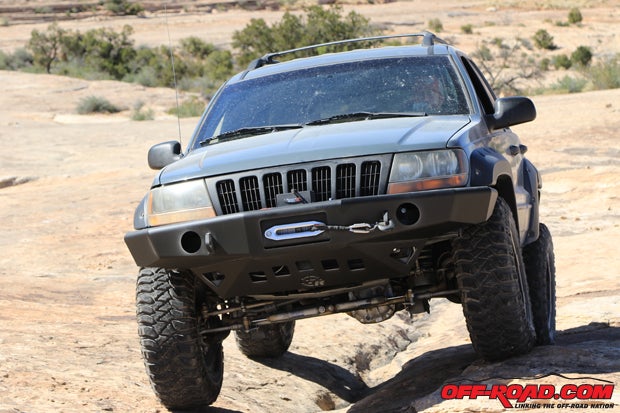
The axles are another issue. The more serious wheelers would say, “Ditch the Dana 30 and 35 and get Dana 44s!” The stronger and more durable Dana 44s would be a great option, though it adds more cost and complexity to the build. Since we wanted to keep costs reasonable and not overbuild what would be a moderate trail rig, we opted to stick with the 30 and 35. Another option would be to upgrade the axles, with something like RCV Performance’s Ultimate Dana 30 CV Axle Set, though this doesn’t come at a low cost either.
The Dana 30 itself has been a bit of a pain. Although we had a similar setup on a Wrangler previously, on our WJ we’ve had trouble with the axle seal leaking after the new gears were installed. Unfortunately the carrier needs to be removed to get at the seals, and therefor the bearing races and seals on both sides will need to be inspected and reinstalled in the same order removed (or replaced depending upon their condition); you can’t simply address one side without having to do the same with the other since the bearings and seals are pressed in on both sides. We had a similar issue with the right seal on the rear axle after re-gearing at first as well. When all is said and done, upgrading the axles would likely be a better route and we’d budget that into the build next time.
One design issue with the WJ is the fuel tank. For the sake of space, the stock spare tire is stored underneath the floorboard of the rear cargo area. The gas tank is then mounted beneath this area, and therefore could get hung up coming off ledges. A heavy-duty skid plate would be ideal, or a more involved (but cool) route would be to cut out the spare tire area and raise up the fuel tank in the space gained.
Speaking of spare tires, we currently don’t have a good place for one. One of the selling points for the Grand Cherokee was its additional cargo space compared to a Wrangler, but at present we have to stuff a spare in the rear cargo area. A space tire carrier for the rear bumper would be an option, or potentially storing it on a roof rack up top, but we had trouble finding a roof rack designed for the WJ.
This leads up to our biggest problem with the platform … availability of parts.
Whether it be a CJ, YJ, TJ or JK, there are thousands of parts available for Wranglers, making them easy to work on, customize, and find parts for which to upgrade your rig. That’s not the case for the WJ. The WJ may require more one-off parts for certain upgrades, or the parts may simply be a little costlier since they aren’t mass-produced.
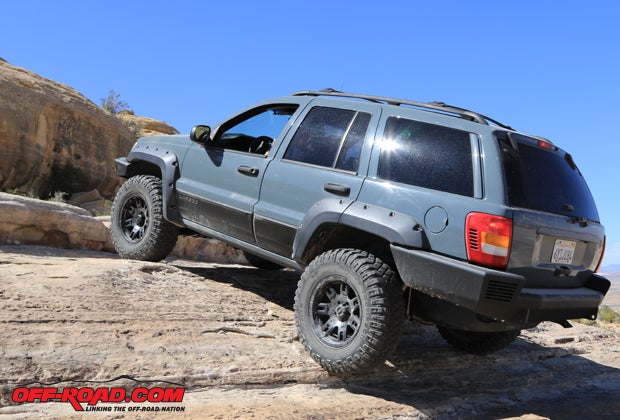
Two engine options are available on the WJ, including the well-known 4.0-liter Power Tech inline six-cylinder (195 hp, 230 lb.-ft.) and a 4.7-liter PowerTech V8 (235 hp, 295 lb.-ft.) that was updated from 2002-2004 (265 hp, 330 lb.-ft.). Weopted for the 4.0-liter motor for its known reliability and for the fact it was the only motor we could find on models fitted with the Selec-Trac NV-242 transfer case, which has a two-wheel-drive setting and won’t stay in full-time four-wheel drive like the NV-247. The 4.0-liter works great on our rig and is still running strong even as we approach 190,000 miles on the Jeep. The added weight on our rig, however, makes a good argument for the 4.7-liter V8, however, so it’s something to keep in mind for those thinking of tackling such a build.
All in all, we are happy with our WJ Project and how it turned out. Every build comes with its share of headaches and complications, but we knew this one would be a little more challenging since we were taking the road less traveled. That just makes the end goal a little more rewarding, even if we still don’t feel like it’s completely done.


 Your Privacy Choices
Your Privacy Choices